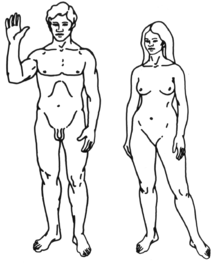Find yourself
Just look at the list of taxons you need to navigate through! I was pretty much stuck at Eumetazoa, let alone Gnathostomata.
Homo sapiens sapiens
From Wikispecies
[edit] Taxonavigation
Main Page
Superregnum: Eukarya
Regnum: Animalia
Subregnum: Eumetazoa
Superphylum: Deuterostomia
Phylum: Chordata
Subphylum: Vertebrata
Infraphylum: Gnathostomata
Superclassis: Tetrapoda
Classis: Mammalia
Subclassis: Theria
Infraclassis: Placentalia
Ordo: Primates
Subordo: Haplorrhini
Infraordo: Simiiformes
Taxon: Catarrhini
Superfamilia: Hominoidea
Familia: Hominidae
Subfamilia: Homininae
Tribus: Hominini
Subtribus: Hominina
Genus: Homo
Species: Homo sapiens
Subspecies: Homo sapiens sapiens



Typical non-scientist attitude! Of course we're in the Eumetozoa and gnathostomata ;o)
And just to elaborate further I've goggled the definition for eumetozoa (such a nerd, I know)....
Eumetozoa: generally multicellular, capable of locomotion and responsive to their environment (debatable for some), and feed by consuming other organisms. Their body plan becomes fixed as they develop, usually early on in their development as embryos, although some undergo a process of metamorphosis later on. (hmmm... think that's called old age).
Also just for shits and giggles: being in the Chordata means we have a nerve cord; Vertebrata because we have a backbone; Gnathostomata beacuse we have jaws; Tetrapoda means we have four legs (well our ancestors did anyway); Haplorrhini includes us in the group of dry-nosed primates (not always the case in winter); and the Catarrhini because we have a narrow nose shape, fewer premolar teeth, and lack of a prehensile tail.
So that's the result of some fairly mindless procrastination during work time...
How handy would a tail be?
Emily!
Non-scientist attitude??? I'm a looove doctor.
Thank you for your research. I find taxonomy very interesting (if not fundamentally flawed).
Please email us and let us know how you're doing. I'm worried (by your last comment) that you're spending too much time with the fishes (so to speak).